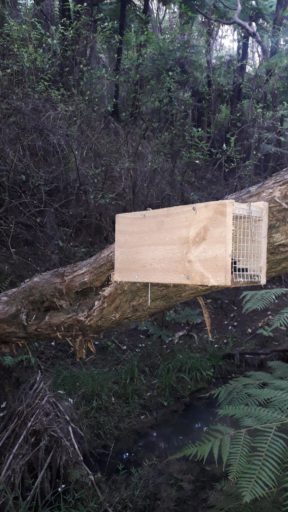Eion Harwood, coordinator for Russell Landcare Trust’s ‘Kiwi Protection’ project, has been spending a lot of time observing rat behaviour on the 15 trail cameras that the group has set up across 450 hectares of the Russell Peninsula where they carry out intensive rat control. The group also carries out stoat and possum control over 2,000 hectares of the Russell Peninsula.

“We can’t do a comprehensive study,” he admits, “but you can gain a lot of knowledge from trapping results, what bait is taken, which traps have caught rats and observing their behaviour. It makes a lot of difference being able to see what is going on. Our main contractor has been great with analysing data and this has also helped answer many questions.”
That observation process – and the fact that most of the rats they catch, indeed the most common rat in most of New Zealand, is the tree-climbing ship rat – led him to develop improved tree-mounted trap boxes.
“Rats are a lot ‘lazier’ than people think,” says Eion, “You have to make it simple and easy and encourage the rat into the trap box. There are so many different aspects to trapping rats: placement of the trap or bait station; in forest – is it a mature tree, a sloping branch? On the Russell Peninsula there are heaps of weka as well as kiwi, so trap boxes also have to be weka-proof. The trail cameras helped with that too. I encourage all pest control groups to use cameras otherwise you don’t really know what is happening out there.”
Eion believes that because ship rats spend a lot of time in trees, a tree-mounted trap box is probably more likely to be encountered and can be mounted in a way that gives easy access to both rats and volunteers.

“We can set up the traps at a nice height and position,” says Eion. “If they’re at eye height they’re quick and easy for volunteers and contractors to service.”
A couple of years ago Eion first trialled tree-mounted trap boxes, using standard ground boxes that are 600mm long – to keep weka out – and have the recommended rat hole size.
“We stuck a camera on and put a ramp on the trap box,” Eion explains. “The box was attached to the tree with a sloping ramp going up and then we observed what happened. We found tree-mounted trap boxes were better to be 3-sided, open at one end, with mesh at the other. It’s a simple design. We developed it, looked at how rats used the opening and trialled it with a few people putting them out.”
Eion soon found the new traps were ‘getting the numbers’.
“The rat numbers were at least 2 or 3 : 1 compared to our other traps and the by-catch was no higher. We do get the odd waxeye – even in the long ground traps and we are always looking at ways to reduce that by-catch.”
Another advantage is how simple the boxes are to make.
“A couple of months ago we had 9 guys working at my place and in a couple of hours, we’d made 100,” says Eion, who had cut the timber the day before, so that the boxes just needed to be assembled. “They’re also easy to carry into bush and easy to service at a nice height.”
Russell Landcare Trust has about 100 tree traps out for the last 6 months, along with 400 ground traps and 1600 bait stations across the 450 hectares where they carry out the intensive rat control.
“So far so good,” says Eion who is pleased with how the tree-mounted traps are performing so far. “It’s another good item in the mix. In the ‘rat industry’ people often want an answer – what trap or bait should I use,” he adds, “But it doesn’t work that way with rats. After 3-5 years rats become trap shy and a trap isn’t effective anymore. You need to have a holistic approach.”
Even in a backyard situation, Eion believes you need to have 4 control options to get on top of rats.
“At Russell Landcare we’re working hard to get as close as possible to zero rats in the 450 hectares we work in – not just suppression, but keeping numbers super low, even with reinvasion. The first 80% are easy, but the last 20% are hard and that’s where skills come into it.”
Read more about the work of Russell Landcare Trust and the Kiwi Protection project:

